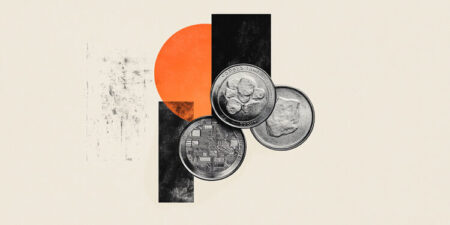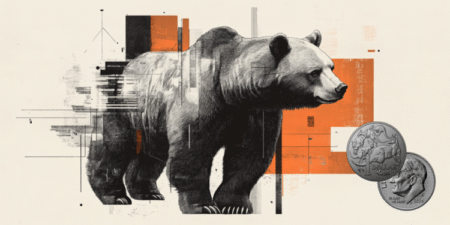- The Pound Sterling edges up slightly against the US Dollar, after the recent rally halted around 1.3600 due to hot US PPI data.
- Tariffs led US producer inflation to grow at the fastest pace in three years, supporting the US Dollar.
- Investors await the US Retail Sales data and the Trump-Putin meeting.
The Pound Sterling (GBP) recovers slightly to near 1.3540 against the US Dollar (USD) on Friday, paring back some of the losses seen on Thursday, when the US Dollar (USD) bounced back strongly after the United States (US) Producer Price Index (PPI) report for July showed that wholesale prices rose at the strongest pace in three years.
During the press time, the US Dollar Index (DXY), which tracks the Greenback’s value against six major currencies, ticks down to near 98.05. Still, it broadly holds the Thursday’s recovery move, which came near the two-week low around 97.60.
Headline and the core PPI – which excludes volatile food and energy items – rose by 0.9% on a month, after remaining flat in June. Hot US PPI data indicate that business owners are reluctant to absorb the impact of tariffs and are passing it on to consumers.
Escalating producer inflation has raised doubts among market experts about whether the Federal Reserve (Fed) will reduce interest rates in September.
“This report is a strong validation of the Fed’s wait-and-see stance on policy changes,” analysts at High Frequency Economics said.
According to the CME FedWatch Tool, traders still see it likely that the Fed will cut interest rates in September. Market expectations for Fed interest rate cuts were intensified by cooling labor market conditions and the absence of signs supporting the flow of tariff effects into prices in the Consumer Price Index (CPI) report of July, released on Tuesday.
Market experts believe that consumer prices rose moderately since the tariff announcement because importers shielded consumers from higher prices by stocking higher inventory before the announcement of reciprocal duties on the so-called “Liberation Day”.
“We anticipate broader signs of tariff-driven inflation in the data over time as inventories roll over and firms adjust pricing under margin pressure,” analysts at Oxford Economics said, CBS News reported.
British Pound PRICE Today
The table below shows the percentage change of British Pound (GBP) against listed major currencies today. British Pound was the strongest against the US Dollar.
| USD | EUR | GBP | JPY | CAD | AUD | NZD | CHF | |
|---|---|---|---|---|---|---|---|---|
| USD | -0.29% | -0.12% | -0.72% | -0.14% | -0.28% | -0.17% | -0.32% | |
| EUR | 0.29% | 0.15% | -0.33% | 0.15% | -0.02% | 0.11% | -0.03% | |
| GBP | 0.12% | -0.15% | -0.52% | -0.01% | -0.17% | -0.05% | -0.19% | |
| JPY | 0.72% | 0.33% | 0.52% | 0.49% | 0.35% | 0.51% | 0.29% | |
| CAD | 0.14% | -0.15% | 0.00% | -0.49% | -0.09% | -0.04% | -0.18% | |
| AUD | 0.28% | 0.02% | 0.17% | -0.35% | 0.09% | 0.05% | -0.02% | |
| NZD | 0.17% | -0.11% | 0.05% | -0.51% | 0.04% | -0.05% | -0.14% | |
| CHF | 0.32% | 0.03% | 0.19% | -0.29% | 0.18% | 0.02% | 0.14% |
The heat map shows percentage changes of major currencies against each other. The base currency is picked from the left column, while the quote currency is picked from the top row. For example, if you pick the British Pound from the left column and move along the horizontal line to the US Dollar, the percentage change displayed in the box will represent GBP (base)/USD (quote).
Daily digest market movers: Pound Sterling trades calmly, UK CPI comes under the spotlight
- The Pound Sterling trades broadly stable, in a calm day, with investors awaiting fresh cues about the likely monetary policy action by the Bank of England (BoE) in the remainder of the year. Financial market participants expect the BoE to hold interest rates at their current levels as price pressures in the United Kingdom (UK) have remained elevated. Additionally, better-than-projected Q2 Gross Domestic Product (GDP) data has come in as relief for policymakers.
- On Thursday, the Office for National Statistics (ONS) reported that the economy rose at a faster pace of 0.3% in the second quarter of the year, stronger than expectations of 0.1%, but slower than the prior release of 0.7%.
- In the near term, economists believe that global trade risks, weak labor demand, and a likely increase in taxes by UK Chancellor of the Exchequer Rachel Reeves in the Autumn Budget could be major drags on economic growth. “We don’t expect growth to pick up much from here as continued consumer caution, weaker global demand, and tax increases all continue to drag,” economists at accountants RSM UK said, Reuters reported. The probability of Reeves raising taxes is high as the Chancellor needs to offset the impact of higher welfare spending, announced in early July, to meet her fiscal target.
- Going forward, investors will focus on the UK Consumer Price Index (CPI) data for July, which is scheduled to be released on Wednesday.
- In Friday’s session, investors will focus on the US Retail Sales data for July, which will be published at 12:30 GMT. Economists expect Retail Sales to have grown by 0.5% on a month, slower than the prior reading of 0.6%.
- On the global front, financial market participants will pay close attention to the meeting between US President Donald Trump and Russian leader Vladimir Putin in Alaska on Friday. US President Trump has called Russian leader Putin to discuss ending the war in Ukraine. According to a report from Reuters, Trump said on Thursday that he believes Putin is ready to end the conflict, but peace would likely require at least a second meeting involving Ukraine’s leader.
Technical Analysis: Pound Sterling faces pressure near 1.3600
the The Pound Sterling trades near 1.3540, down from the two-month high of 1.3600 posted on Thursday. The near-term trend of the GBP/USD pair remains bullish as it holds the 20-day Exponential Moving Average (EMA), which trades around 1.3450.
The 14-day Relative Strength Index (RSI) strives to break above 60.00. A fresh bullish momentum would emerge if the RSI breaks above that level.
Looking down, the August 11 low of 1.3400 will act as a key support zone. On the upside, the July 1 high near 1.3790 will act as a key barrier.
Economic Indicator
Producer Price Index (MoM)
The Producer Price Index released by the Bureau of Labor statistics, Department of Labor measures the average changes in prices in primary markets of the US by producers of commodities in all states of processing. Changes in the PPI are widely followed as an indicator of commodity inflation. Generally speaking, a high reading is seen as positive (or bullish) for the USD, whereas a low reading is seen as negative (or bearish).
Read more.
Read the full article here















